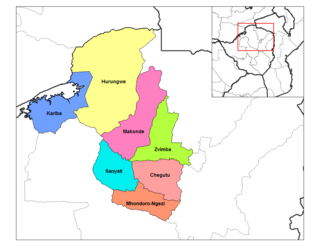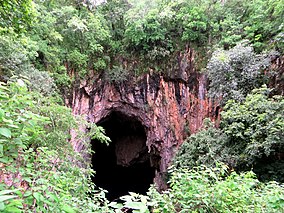
Nyanga is a town in Zimbabwe. At one time, the town was known as Inyanga.
Alaska is a small town in central northern Zimbabwe in Makonde District, Mashonaland West Province.
Sanyati is a town in Zimbabwe.
Colleen Bawn is a town in Zimbabwe.
Lion's Den is a small town in Zimbabwe.

Kadoma, formerly known as Gatooma, is a town in Zimbabwe.
Karoi is a town in Zimbabwe.
Chinhoyi, known until 1982 as Sinoia, is a city in central northern Zimbabwe in the Makonde District. It has a population of 90,800 and is primarily a college town, although it was originally founded as an Italian group settlement scheme. The nearby Chinhoyi Caves and national park are a popular attraction.

Mwami is a settlement in the province of Mashonaland West, Zimbabwe.
Mount Darwin is a town in Mashonaland Central province in Zimbabwe.

Chimanimani is a town in Zimbabwe.
Murombedzi is a town in Zimbabwe.

Karoi District is a district of Mashonaland West Province, Zimbabwe. The district is also known as Hurungwe District which extends to Zambian border. The Hurungwe district office are found in Karoi town.

Chegutu District is a district of Mashonaland West Province, Zimbabwe. The district headquarters is located in Chegutu, a city which lies of the Harare-Bulawayo Road,.

Zvimba District is a district of Mashonaland West Province, Zimbabwe.
Makonde District is a district in Zimbabwe.
Murambinda is a town in Zimbabwe.
R3 Highway is a primary road in Zimbabwe from the capital city Harare to the Chirundu Border Post with Zambia. It is also known as the A1 Highway. It is part of both the Beira–Lobito Highway and the Cape to Cairo Road.

Chirundu–Beitbridge Road Corridor is a Trans-African Highway Network Zimbabwean link between South Africa and Zambia. It is part of the North–South Corridor Project and forms the entire Zimbabwean section of the Cape to Cairo Road.
The M15 Makuti-Kariba Highway is a 2-way asphalt surface international highway from the A1 Highway at Makuti to Zambia via the Kariba Dam Wall. The maximum speed on this road is 120 kilometres (75 mi) per hour.






